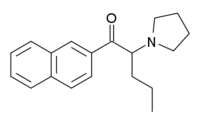Life in the TOO fast lane?
aka Toxicology Conundrum 040
Guest Post: Leon Gussow, the force behind The Poison Review, to bring you this post on the toxicity of new recreational drugs. Leon recently authored this must-read article ‘Coming Soon to an ED Near You‘

There has been an avalanche of new recreational drugs hitting the streets recently. It is almost impossible to keep up with the ever-changing drug scene and reliable information is scanty. Apart from a few anecdotal reports, most of the information available to clinicians comes from those involved in drug culture. Given these limitations, treatment of toxicity from these new recreational drugs should be guided by the clinical manifestations and the known pharmacology of these agents. Meticulous supportive care is paramount and some soothing benzodiazepines are probably helpful in most cases.
Are you ready to test your knowledge of these new agents?… You’d better be, after all, they will be coming to an ED near you soon.
Bromo-DragonFLY
Q1. How is Bromo-DragonFLY typically purchased?
Answer and interpretation
BDF is usually sold as a “plant food” or “research chemical” and is often purchased over the Internet. It has no known medical or industrial use.
Q2. How did bromo-DragonFLY get its name?
Q3. What is known about the pharmacological action of Bromo-DragonFLY?
Answer and interpretation
BDF has a high affinity for 5-HT2A serotonin receptors (typical of phenylethylamines) and is an alpha-1 agonist.
Q4. What are the clinical effects of Bromo-DragonFLY?
Answer and interpretation
5-HT2A effects:
- potent hallucinogen
alpha-1 effects:
- intense peripheral vasoconstriction and hypertension
- limb ischemia
- probably can cause coronary vasospasm
- other ischemic multi-organ effects (e.g. ischemic hepatopathy)
Tachycardia, agitation and seizures may occur
BDF toxicity can be devastating and fatal

Q5. What is the time course of the clinical effects of Bromo-DragonFLY?
Answer and interpretation
The clinical manifestations of BDF generally have:
- a delayed onset to peak effect (up to six hours)
- prolonged duration (up to several days)
It was like being dragged to hell and back again. Many times. It is the most evil [thing] I’ve ever tried. It lasted an eternity
Danish user of Bromo-DragonFLY
Mephedrone
Q1. What are some of the street names of mephedrone?
Answer and interpretation
This drug has only been on the scene in the UK (where it is already banned) and the States over the past 3 or so years. Street names include Meow, Drone, Bubble, M-Cat, and Milton Keynes (when combined with ketamine).
Q2. What is known about the clinical pharmacology of mephedrone?
Answer and interpretation
Mephedrone , or 4-methylmethcathinone, has a structure similar to cathinone (Khat) and appears to be a potent sympathomimetic agent. Mephedrone has a short half life ( 30-90 min) with effects typically lasting 2-4 hours.

Q3. How is mephedrone usually administered?
Answer and interpretation
Mephedrone usually comes as a clear white powder hence the incorporation into ‘bath salts’. It is also found as crystals, capsules and pills. The powder form is usually mixed with water and swallowed (bombed) but can be sniffed/snorted or taken intravenously.
Q4. What are the clinical effects of mephedrone?
Answer and interpretation
Sympathomimetic
- intense peripheral vasoconstriction
- palpitations, diaphoresis, tachycardia, hypertension, pupillary dilatation
CNS effects
- anxiety, panic attacks, and paranoia
- severe hallucinations with heavy use
- addictive
The expected complications and management of mephredrone toxicity are similar to that of amphetamine toxicity, as described here.
Nexus (2C-B)
Q1. What are the street names for Nexus/ 2C-B?
Answer and interpretation
Nexus also goes by the names of Bees, Venus, Erox, Performax, Toonies, and Bromo mescaline to name a few.
Q2. How is Nexus/ 2C-B usually administered?
Answer and interpretation
It is typically supplied as a white powder or a tablet, and is usually ingested or snorted.
Q3. What is known about the pharmacological action of Nexus/ 2C-B?
Q4. What are the clinical features of Nexus/ 2C-B intoxication?
Answer and interpretation
- intense nasal pain (<30 min duration) following snorting
- CNS effects (probably predominantly due to 5HT2 agonism):
euphoria, increased visual and tactile sensations, relaxation, synesthesia, and hallucinations - potential for alpha-1 mediated vascoconstriction and ischemia
(persistent neurological deficits attributed to cerebral ischemia have been reported)
Q5. What is the time course of the clinical effects of Nexus/ 2C-B?
Answer and interpretation
Time course of the clinical effects of Nexus:
- Onset 30 to 90 min after ingestion
- Duration of effect 4-8 hours
K2/Spice
Q1. How was K2/Spice created?
Answer and interpretation
K2/Spice is a cannabinoid analogue originally used in research to investigate different types of cannabinoid receptors (CB1R in the CNS mediates psychotrpoic effects and CB2R modulates immune cell function). The agent was subsequently synthesised by ‘street chemists’ and added to herbal mixtures and tobacco.
Q2. What are the clinical effects of K2/Spice?
Answer and interpretation
Little is known, though it may have stronger psychotropic effects than marijuana.
Salvia
Q1. What is Salvia?
Answer and interpretation
Salvia divinorum is a perennial plant in the mint family. Historically it was used by the Mazatec Indians of Mexico in shamanistic rituals for its hallucinogenic properties.
Q2. What is Salvia’s active ingredient and what is its mechanism of action?
Answer and interpretation
The active ingredient is salvinorin A.
Salvinorin A selectively stimulates kappa opioid receptors in the brain and spinal cord, and can be blocked by naloxone. Thus Salvinorin A is has a mechanism of action unlike most hallucinogens, which are typically 5HT2A receptor agonists

Q3. What are the clinical effects of Salvia?
Answer and interpretation
Clinical effects:
- Vivid hallucinations that may last ~10 minutes when Salvia is smoked.
- Salvinorin A can also cause spinal anesthesia.
Thus far there have been no reports of significant toxicity.
Naphyrone, NRG-1
Q1. What is naphyrone?
Answer and interpretation
Naphyrone is a synthetic chemical derived from pyrovalerone.
It’s arrival in the wake of the banning of mephredrone in the UK highlights the the growing public health problem of rapidly emerging legal highs in an age of internet marketing.
Naphyrone is also known as NRG-1, however batch analysis of some NRG-1 samples highlights another problem with the the influx of new recreational agents: they may or may not contain the supposed active ingredient.

Q2. Describe the clinical pharmacology of naphyrone.
Answer and interpretation
Naphyrone is a ‘triple uptake inhibitor’, it potently inhibits the reuptake of noradrenaline, dopamine and serotonin. The clinical effects are yet to be well characterized.
Methoxetamine
Q1. What is methoxetamine?
Answer and interpretation
Methoxetamine is an analogue of ketamine and phenylcyclidine (PCP) that is typically sold as a ‘research chemical’.
It’s street names include: M-ket, Kmax, Mexxy and Special K (note: ketamine also appears under this street name)
Q2. Describe the clinical pharmacology of methoxetamine.
Answer and interpretation
This isn’t well understood — the first laboratory confirmed case was published in January 2012 — but it likely has similar pharmacodynamics to ketamine and PCP.
Compared to ketamine, methoxetamine appears to have a more delayed onset (up to 90 min) and longer duration of action (5-7 hours).
Q3. What are the clinical effects of methoxetamine?
Answer and interpretation
The effects described are typical of the adverse effects of ketamine:
- tachycardia, hypertension, confusion, agitation, mydriasis
- an acute cerebellar syndrome, characterised by dysarthria, nystagmus, and ataxia, that can be severe and may even last days
- Withdrawal symptoms have also been described.
Methoxetamine is purported not to cause cystitis and bladder fibrosis, two well-known effects of chronic ketamine abuse.
References
- Meow Meow Mephredrone
- I’m Just Trying To Get Clean Bro’
- Novel Psychoactive Substances – Recreational Drug Toxicity – David M. Wood (United Kingdom)
- Special Report: Coming Soon to an ED Near You: Bromo-Dragonfly (Not an Insect), K2 (Not a Mountain), and Venus (Not the Planet)
- Salvia divinorum: A Unique Hallucinogen
- Clandestine Drug Labs: High Risk for Fire, Explosion, and Toxic Exposure
Bath Salts
- Bath salts: calls to poison centers in Louisiana and Kentucky
- New England Journal of Medicine on “Bath Salts” New York Times on Bath Salts
- NBC’s Dateline goes undercover to investigate the “bath salt” industry
- “Bath salts” in Michigan Were “bath salts” involved in a double murder/suicide in Washington State?
- Dr. Oz on bath salts (MDPV)
- NBC’s Today Show reports on bath salts (MDPV)
- Death in Britain: “Ivory Wave” (MDPV) or diabetic ketoacidosis
- “Ivory Wave” identified as MDPV
- It’s not your mom’s bath salts
Bromo-DragonFLY
Mephredrone
- Mephedrone (meow-meow): first confirmed case report
- Mephedrone after the ban Woof-woof: the new meow-meow?
- Mephedrone review
- Confirmed mephedrone-associated fatality
- How does the body handle mephedrone and other designer drugs?
Methoxetamine
Naphyrone
- The chemistry of naphyrone
- NRG-1? Buphedrone? Flephedrone? — What will follow meow-meow and where will it come from?
New Recreational Drugs
- Comprehensive review of new designer drugs
- The science of designer drugs: essential review
- “Party pills”: review of BZP and TFMPP
Nexus/ 2-CB
Salvia

CLINICAL CASES
Toxicology Conundrum
Chris is an Intensivist and ECMO specialist at The Alfred ICU, where he is Deputy Director (Education). He is a Clinical Adjunct Associate Professor at Monash University, the Lead for the Clinician Educator Incubator programme, and a CICM First Part Examiner.
He is an internationally recognised Clinician Educator with a passion for helping clinicians learn and for improving the clinical performance of individuals and collectives. He was one of the founders of the FOAM movement (Free Open-Access Medical education) has been recognised for his contributions to education with awards from ANZICS, ANZAHPE, and ACEM.
His one great achievement is being the father of three amazing children.
On Bluesky, he is @precordialthump.bsky.social and on the site that Elon has screwed up, he is @precordialthump.
| INTENSIVE | RAGE | Resuscitology | SMACC


